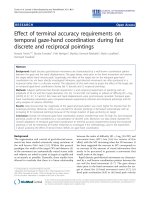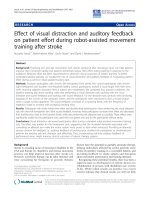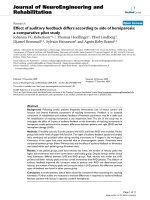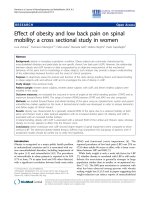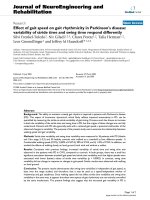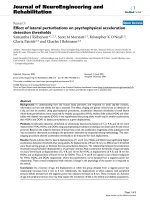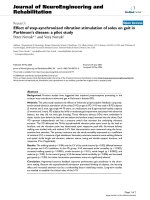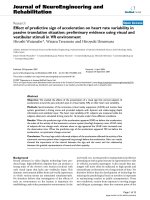Báo cáo hóa học: " Effect of Ebola virus proteins GP, NP and VP35 on VP40 VLP morphology" docx
Bạn đang xem bản rút gọn của tài liệu. Xem và tải ngay bản đầy đủ của tài liệu tại đây (916.21 KB, 7 trang )
BioMed Central
Page 1 of 7
(page number not for citation purposes)
Virology Journal
Open Access
Research
Effect of Ebola virus proteins GP, NP and VP35 on VP40 VLP
morphology
Reed F Johnson
1
, Peter Bell
2
and Ronald N Harty*
1
Address:
1
Department of Pathobiology, School of Veterinary Medicine, University of Pennsylvania, 3800 Spruce St., Philadelphia, PA 19104, USA
and
2
Gene Therapy Program, Department of Pathology and Laboratory Medicine, School of Medicine, University of Pennsylvania, Philadelphia,
PA 19104, USA
Email: Reed F Johnson - ; Peter Bell - ; Ronald N Harty* -
* Corresponding author
Abstract
Recently we described a role for Ebola virus proteins, NP, GP, and VP35 in enhancement of VP40
VLP budding. To explore the possibility that VLP structure was altered by co-expression of EBOV
proteins leading to the observed enhancement of VP40 VLP budding, we performed density
gradient analysis as well as electron microscopy studies. Our data suggest that VP40 is the major
determinant of VLP morphology, as co-expression of NP, GP and VP35 did not significantly change
VLP density, length, and diameter. Ultra-structural changes were noted in the core of the VLPs
when NP was co-expressed with VP40. Overall, these findings indicate that major changes in
morphology of VP40 VLPs were likely not responsible for enhanced budding of VP40 VLPs in the
presence of GP, NP and/or VP35.
Introduction
Ebola and Marburg viruses are members of the Filoviridae
family of the order Mononegavirales. Both viruses are asso-
ciated with recurrent outbreaks of deadly hemorrhagic
fevers with mortality rates as high as 90% [1,2]. Currently,
there are no approved vaccines, nor treatments for Ebola
virus (EBOV) infection. A better understanding of the
molecular aspects of EBOV replication will be necessary
for successful development of specific treatments for
EBOV infection.
Ebola virus matrix protein, VP40, is the major virion pro-
tein and plays an essential role in virus assembly and bud-
ding [3,4]. VP40 buds from the cell surface forming virus-
like particles (VLPs). VLP budding is mediated by viral L-
domains present in the N-terminus of the protein, which
interact with host factors such as Nedd4 and TSG101,
leading to VLP release [3-7]. It is hoped that investigations
into the mechanisms of VP40 VLP budding will lead to
possible vaccines and therapeutics that will block late
stages of the virus life-cycle.
Recent evidence suggests that co-expression of other
EBOV proteins will enhance VP40 VLP budding [8,9]. For
example, co-expression of VP40+GP+NP enhanced VP40
release approximately 40-fold over that observed for VP40
alone [9]. We have also demonstrated that VP35 interacts
with VP40, is enclosed within VP40 VLPs, and functions
to specifically package the EBOV 3E-5E minigenome into
VLPs [10]. Currently, the mechanism by which EBOV pro-
teins enhance VP40 budding is unclear, as is their affect
on VLP morphology. Thus, we are interested in examining
VLPs that contain combinations of VP40, GP, NP, and
VP35 to determine whether co-expression of different
EBOV proteins affects density, length, diameter, and over-
all morphology. Investigating the morphology of EBOV
Published: 23 May 2006
Virology Journal 2006, 3:31 doi:10.1186/1743-422X-3-31
Received: 26 April 2006
Accepted: 23 May 2006
This article is available from: />© 2006 Johnson et al; licensee BioMed Central Ltd.
This is an Open Access article distributed under the terms of the Creative Commons Attribution License ( />),
which permits unrestricted use, distribution, and reproduction in any medium, provided the original work is properly cited.
Virology Journal 2006, 3:31 />Page 2 of 7
(page number not for citation purposes)
VLPs may give us insight into the mechanism by which
EBOV proteins contribute to the observed enhancement
of VLP budding.
Early EBOV reports suggest the virus particle is 970 nm in
length and 80 nm in diameter with a density of 1.14 g/mL
[11-13]. Since EBOV is a bio-safety level 4 pathogen, alter-
nate means to study its properties have been developed.
The most commonly used method to study EBOV pro-
teins is transfection and co-expression of plasmids coding
for individual viral proteins. Using this approach, Bavari
et al. have demonstrated that co-expression of VP40 and
GP yielded VLP particles 50–70 nm in diameter and 1–2
µm in length [13], while Jasenosky et al. determined the
VP40 VLP particle density to be 1.11–1.13 g/ml [4]. In
addition, Noda et al. demonstrated that GP formed 10 nm
long spikes on the surface of VP40 VLPs, and VLPs were
found to be 10 µm in length.
In this report, we performed sucrose density gradient sed-
imentation, electron microscopy (EM), and protease pro-
tection assays on VLPs from cells transfected with
combinations of VP40, GP, NP, and/or VP35. We demon-
strate that there are minimal changes in VLP density,
diameter, and wall thickness with co-expression of other
viral proteins. Statistically significant differences were
found in measurements of wall thickness between VP40
VLPs and VP40+VP35 VLPs. Lastly, NP was packaged
within VP40+NP VLPs, and VLP morphology was altered
when NP was co-expressed with VP40.
Results
NP is packaged within VP40 VLPS
We have demonstrated previously that NP enhances VP40
VLP budding 3.5 fold over VP40 alone, but did not dem-
onstrate that NP was packaged within VP40 VLPs [9]. To
prove that NP is packaged within VP40 VLPs, protease
protection assays were performed. Similar experiments
have been performed with VP35 to demonstrate that
VP35 is also packaged within VP40 VLPs [10]. Human
293T cells were transfected with pCAGGS vector alone,
VP40, NP, or VP40+NP. Purified VLPs were divided into
six equal fractions. As reported previously, VP40 was only
digested in the presence of both Triton X-100 and trypsin
(Fig 1A, Lane 5) [6]. Similarly, we found that NP was
degraded completely only in the presence of both Triton
X-100 and trypsin (Fig. 1B, lane 5). Treatment with trypsin
alone was insufficient to digest NP (Fig 1B, lane 4), indi-
cating that NP is packaged within VP40 VLPs. It should be
noted that NP was unable to bud from cells as a VLP when
expressed alone in mammalian cells [9].
VP40 is the major determinant of EBOV VLP density
VLP density was determined by centrifugation of VLPs
purified from transfected 293T cells over 20% sucrose in
STE, followed by centrifugation on a 20–50% sucrose gra-
dient for 14 hours. Five hundred microliter fractions were
collected and analyzed for density using a refractometer.
Fractions positive for VP40 as determined by Western blot
were converted to density. Table 1 lists the densities for
each combination of EBOV proteins expressed, and these
data represent an average of 7 independent experiments.
The average density of VP40 VLPs was 1.102 g/mL. Co-
expression of VP35 and VP40 increased VLP density to
that of 1.125 g/mL. Co-expression of VP40+VP35+NP
yielded VLPs with a density of 1.118 g/mL, whereas
VP40+NP VLPs had a density of 1.102 g/mL (Table 1).
These data indicate a slight decrease in VLP density with
the inclusion of GP to VP40 VLPs yielding a density of
1.091 g/mL. When NP was included with VP40+GP, the
density increased to 1.104 g/mL; closer to that obtained
with VP40 alone. It should be noted that no statistically
significant differences were measured, and each VLP den-
sity measurement was well within the standard deviation
of VP40 VLPs of 0.026 (Table 1). The density of the VLPs
suggests that VP40 is the major determinant of density of
the VLP particle. Jasenosky et al reported VP40 VLP den-
sity of 1.11 to 1.13 g/mL, which is close to EBOV observa-
Protease Protection Assay of VLPs containing NP and VP40Figure 1
Protease Protection Assay of VLPs containing NP and VP40.
VLP pellets were split into six fractions and treated with STE
buffer (lane 1), soybean trypsin inhibitor (lane 2), Triton X-
100 (lane 3), Trypsin (lane 4), Trypsin and Triton X-100 (lane
5), Trypsin and soybean trypsin inhibitor (lane 6). The frac-
tions were divided equally, and viral proteins were immuno-
precipitated with α-VP40 (Panel A), or α-NP (Panel B).
Samples were resolved by SDS-PAGE and detected by auto-
radiography.
Table 1: VLP Density on 20–50% sucrose in STE.
Density
g/mL
Standard
Deviation
pNUM (t-test
compared to
VP40)
VP40 (n = 7) 1.102 0.0262
VP40+VP35 (n = 7) 1.125 0.003 0.5
VP40+VP35+NP (n = 7) 1.118 0.006 0.15
VP40+NP (n = 7) 1.102 0.035 0.34
VP40+GP (n = 7) 1.091 0.038 0.45
VP40+NP+GP (n = 7) 1.104 0.031 0.27
Virology Journal 2006, 3:31 />Page 3 of 7
(page number not for citation purposes)
tions (1.14 g/mL) [4,11,12]. Our findings suggest that
VP40 determines density of the VLP particle, as co-expres-
sion of EBOV proteins did not significantly change VLP
density.
Electron microscopic analysis of EBOV VLPs
Combinations of EBOV proteins (VP40, VP40+VP35,
VP40+VP35+NP, VP40+NP+GP) were expressed in 293T
cells, and samples were prepared for analysis by electron
microscopy. Measurements of length, diameter, and wall
thickness were taken for each set of VLPs, and these values
were compared to those obtained for VP40 alone. Overall
length of VLPs was measured (Fig. 2 and Fig. 3) resulting
in an average length of 540.70 nm for VP40 VLPs, 575.83
nm for VP40+VP35, 686.15 nm for VP40+VP35+NP, and
609.36 nm for VP40+NP+GP. It should be noted that
length measurements likely reflect a mixture of full and
partial-length VLPs. We identified several particles that
correlated with full-length measurements reported previ-
ously by Bavari et al. (1.0–2.0 µm) [13]. The largest over-
all length of 1277 nm was observed for VP40+NP+GP
VLPs, while the smallest overall length of 204 nm was
observed for VP40 alone.
VP40 VLPs had an average diameter of 57.58 nm, with
slight increases for VP40+VP35 at 63.64 nm,
VP40+VP35+NP at 60.35 nm, and VP40+NP+GP at 66.57
nm (Fig. 2). These data are consistent with diameters
reported by Bavari et al of 50–70 nm and narrower than
that reported for EBOV of 80 nm [13]. These data support
a role for VP40 as the major component that determines
VLP length and diameter. Co-expression of NP, GP, and/
or VP35 did not significantly alter VLP diameter. (Fig. 2.)
A morphological difference was observed following exam-
ination of cross-sections of VLPs expressing VP40 alone
vs. those expressing additional EBOV proteins. For exam-
ple, VP40 and VP40+VP35 VLPs had disorganized centers,
while VLPs which included NP possessed a "bull's-eye"
appearance (Fig. 4). In addition, the region around the
A. Electron micrographs of individual VLP particles demonstrating the dimensions measuredFigure 2
A. Electron micrographs of individual VLP particles demonstrating the dimensions measured. B. Summary measurements of
VLP Length, Diameter, and Wall Thickness. The data demonstrate that measured differences between VLPs are not statistically
significant, except for VP40+VP35 VLPs. The (*) indicates statistically significant differences.
Virology Journal 2006, 3:31 />Page 4 of 7
(page number not for citation purposes)
membrane appeared more uniform in VLPs that included
NP (Fig. 4). Next, we measured the wall thickness of VLPs
in cross section (see Figure 2 for detailed description of
what we defined as diameter and "wall thickness"). The
average measurement of wall thickness was 17.48 nm for
VP40 VLPs, 21.15 nm for VP40+VP35, 17.67 nm for
VP40+VP35+NP, and 18.55 nm for VP40+NP+GP (Figs. 2
and 4). A statistically significant difference was found
between VP40 and VP40+VP35 with a pNum value of
0.008.
Conclusion
Overall, expression of GP, NP and/or VP35 with VP40 did
not drastically affect VLP density or diameter. However,
wall thickness increased slightly with co-expression of
VP35 and VP40. We also observed packaging of NP within
VP40+NP VLPs and altered VLP morphology when NP
was co-expressed with VP40+GP or VP40+VP35. These
data suggest that VP40 is the major determinant of VLP
morphology. These data support prior findings by Noda,
Bavari, and Jasenosky [4,5,13], and expand upon these
findings by incorporation of NP and VP35 into VLPs.
Our data demonstrate that VLP density increased with the
inclusion of the nucleocapsid proteins NP and VP35
(NP+VP35 – 1.118 g/mL, VP35 – 1.125 g/mL) suggesting
that these VLPs may be more organized and more closely
resemble authentic virus particles. In contrast, when GP
was co-expressed with VP40, a slight decrease in density
was observed (1.102 vs. 1.091). This may be due to a
change in morphology of the particle and a resulting retar-
dation in the sucrose gradient by extension of GP from the
VLP surface [5]. VP40+NP+GP and VP40+NP VLPs had
densities roughly equal to that of VP40 alone, with
VP40+NP particles being slightly denser. These findings
suggest that the contribution of NP to density of the par-
ticle offsets the decrease in density by GP. Statistical anal-
ysis suggests that the densities are within one standard
deviation of the density of VP40 alone. It is also important
to point out that densities observed here and by Jasenosky
Electron micrographs for A) VP40 VLPs, B) VP40+VP35 VLPs, C) VP40+VP35+NP VLPs, and D) VP40+NP+GP VLPsFigure 3
Electron micrographs for A) VP40 VLPs, B) VP40+VP35 VLPs, C) VP40+VP35+NP VLPs, and D) VP40+NP+GP VLPs.
Virology Journal 2006, 3:31 />Page 5 of 7
(page number not for citation purposes)
et al. are slightly less than that observed for mature virions
(1.14 g/mL). This difference could be due to complete
incorporation of nucleocapsids and less variability in par-
ticles produced due to infection vs. transfection.
Morphometric analyses suggest that there are differences
in the lengths of the VLP particles (Fig. 2); however, length
measurements likely vary due to the possibility that com-
plete VLP particles were not consistently measured.
Indeed it is likely that only a portion of a VLP was meas-
ured due to the VLP exiting the plane of section being
inspected. Analysis by EM also suggests that there were
slight differences in VLP diameter with co-expression of
the nucleocapsid components VP35 and NP (Fig. 2).
These differences were not found to be statistically signif-
icant. Overall particle diameter was as follows: 57.58 nm
for VP40 VLPs, 63.64 nm for VP40+VP35 VLPs, 60.35 nm
for VP40+VP35+NP VLPs, and 66.57 nm for
VP40+NP+GP VLPs. The increase in diameter of particles
containing VP35 correlates with cross-sectional observa-
tions of wider particles with no organized centers (Fig. 4).
Additionally, morphological differences were evident in
VLPs expressing NP (bull's-eye, Fig. 4). The formation of
the bull's-eye within the VP40+VP35+NP VLPs and
VP40+NP+GP VLPs may indicate that NP self-aggregated
(as is seen with Marburg NP [14]) resulting in electron-
dense material within VLPs. VP40+VP35+NP VLPs were
also slightly more narrow than those containing
VP40+VP35, suggesting an organization of the core of the
virus imparted by NP+VP35 nucleocapsid formations
[15]. The "bull's-eye" present in VP40+GP+NP VLPs along
with the results of the protease protection assay suggest
that NP is packaged within VLPs.
The wall thickness of the VLPs containing EBOV proteins
was found to vary. Indeed, statistical analysis indicated a
significant difference between VLPs containing VP40
alone vs. those containing VP40+VP35. Gross inspection
of the particles indicated a less uniform appearance and
thickening of the VLP wall in VP40+VP35 VLPs. When NP
was co-expressed, the wall appeared more uniform
around the circumference of the VLP, suggesting that NP
has an organizing effect during the formation of VLPs.
In sum, our data suggest that VP40 is the major determi-
nant of VLP density, and co-expression of NP, GP, and/or
VP35 had minor affects on VLP morphology. It will be of
interest to use immuno-EM to more precisely map the
location of EBOV proteins within VLPs. Thus, the
enhancement of VP40 release following co-expression of
additional EBOV proteins [8,9] is unlikely to be due to
gross changes in VLP morphology. One possibility is that
Representative examples of VLPs in cross sectionFigure 4
Representative examples of VLPs in cross section. Note the appearance of a bull's-eyes structure within VLPs containing NP.
Virology Journal 2006, 3:31 />Page 6 of 7
(page number not for citation purposes)
enhancement of VP40 release may be due to modifica-
tions of the cellular architecture, or effects on host protein
function as a result of EBOV protein expression [16].
Materials and methods
Cells, plasmids, and antibodies
293T cells were maintained in Dulbecco Modified Eagles
Media (DMEM) 10% FBS, 5% CO
2
. pCAGGS, pCAGGS
VP40, pCAGGS NP, and pCAGGS GP have been described
previously [9]. The pCAGGS VP35 construct was provided
by Chris Basler (Mount Sinai, New York) and contains an
influenza hemagglutanin (HA) epitope tag at the amino
terminus of VP35. Antibodies to VP40 were provided by
Roland Grunow (Marburg, Germany). Antibodies to NP
were provided by Jason Paragas (Fort Detrick, USAM-
RIID). Antibodies to GP were provided by Paul Bates
(Univ. of Penn). HA antibody was obtained from Roche.
Protease protection assay
VLP budding assays were performed as described previ-
ously [4,6,17] with minor modifications as follows. 293-
T cells on 100 mm tissue culture dishes (Corning) were
transfected with 10 µg of pCAGGS, pCAGGS VP40, or
pCAGGS NP+ pCAGGS VP40 plasmids using Lipo-
fectamine (Invitrogen). 1600 µCi of [
35
S]Met/Cys (Perkin
Elmer) was added to each 100 mm dish 24 hours post-
transfection. At thirty hours post transfection, culture
medium was clarified at 1500 rpm for 10 minutes, layered
over a 20% sucrose in STE buffer (0.01 M Tris-HCl [pH
7.5], 0.01 M NaCl, 0.001 M EDTA [pH 8.0]) cushion, and
VLPs were purified at 36,000 rpm for 2 hours at 4°C. VLPs
were suspended in 400 µL of STE buffer and divided into
six, 60 µL fractions. The fractions were treated with either
6 µL of STE buffer, 3 mg/mL soybean trypsin inhibitor
(Roche Biochemicals), 1% Triton X-100 (Fisher), 0.1 mg/
mL trypsin (Promega), 1% Triton X-100 and 0.1 mg/ml
trypsin, or 0.1 mg/ml trypsin and 3 mg/mL trypsin inhib-
itor. All fractions were incubated at room temperature for
30 minutes followed by the addition of 25 µL of soybean
trypsin inhibitor at a concentration of 100 mg/mL to
quench the reactions. Each fraction was lysed in RIPA
buffer (50 mM Tris [pH 8.0], 150 mM NaCl, 1.0% NP-40,
0.5% deoxycholate, 0.1% sodium dodecyl sulfate [SDS])
in a final volume of 500 µL. Proteins were immunoprecip-
itated with appropriate antibodies, and resolved by SDS-
Polyacrylamide gel electrophoresis (PAGE). As a control
for protein expression, the transfected cells were lysed in
RIPA buffer and split into equal fractions. Immunoprecip-
itated proteins were resolved by SDS-PAGE, and visual-
ized by autoradiography.
VLP density analysis
VLP budding assays were performed as described previ-
ously [4,6,17] with minor modifications as follows. 293T
cells on 100 mm tissue culture dishes (Corning) were
transfected with 10 µg of pCAGGS, pCAGGS VP40,
pCAGGS VP35+pCAGGS VP40, pCAGGS NP+pCAGGS
VP40, or pCAGGS VP40+pCAGGS GP, or pCAGGS
VP40+pCAGGS NP+pCAGGS VP35, or pCAGGS
VP40+pCAGGS NP+pCAGGS GP plasmids using Lipo-
fectamine (Invitrogen). VLPs were purified over 20%
sucrose as previously described [4,5,9]. VLPs were resus-
pended in 500 µL STE buffer and overlayed onto a 20–
50% sucrose gradient prepared in STE buffer. VLPs were
centrifuged at 36,000 × G for 14 hours and 0.5 mL frac-
tions were collected for each sample. An equal portion of
each fraction was run on a 10% SDS-PAGE gel, transferred
and probed with anti-VP40 antibody. Transfected cells
were lysed in RIPA buffer and electrophoresed over a 10%
SDS-PAGE gel, transferred and probed with anti-VP40,
anti-GP, anti-NP, and anti-HA to ensure that all viral pro-
teins were expressed.
Electron microscopy and morphometry
Human 293T cells on 6-well tissue culture dishes (Corn-
ing) were transfected with 1 µg of pCAGGS, pCAGGS
VP40, pCAGGS VP40+pCAGGS VP35, pCAGGS
VP40+pCAGGS NP, or pCAGGS VP40+pCAGGS GP, or
pCAGGS VP40+pCAGGs NP+pCAGGS VP35, or pCAGGS
VP40+pCAGGS NP+pCAGGS GP plasmids using Lipo-
fectamine (Invitrogen). Transfected cells were harvested
and centrifuged at 3000 rpm in a microcentrifuge for 5
min to form a loose pellet. Cell pellets were then fixed
overnight in 2.5% glutaraldehyde, 2% paraformaldehyde
in 0.1 M sodium cacodylate buffer (pH 7.3), washed in
cacodylate buffer, and incubated in 2% OsO
4
for 2 hours.
After washing with water, samples were stained overnight
in 0.5% uranyl acetate, washed again, dehydrated through
a graded ethanol series and propylene oxide, and finally
embedded in resin (LX-112, Ladd Research Industries).
Ultrathin sections (80 nm) were stained with uranyl ace-
tate and lead citrate according to standard protocols and
examined with a Philips CM-100 transmission electron
microscope equipped with a KeenView digital camera sys-
tem. Morphometric measurements were performed on
digital images using AnalySIS software (Soft Imaging Sys-
tem, Lakewood, CO).
Acknowledgements
The authors wish to thank S. Hanna and L. Altamura for help with density
gradient analysis. This work was supported in part by NIH grant AI46499
to R.N.H., and R.F.J. was supported by NIH T32-AI55400.
References
1. Peters CJ, Jahrling PB, Ksiazek TG, Johnson ED, Lupton HW: Filovi-
rus Contamination of Cell Cultures. Dev Biol Stand 1992,
76:267-274.
2. Sullivan N, Yang ZY, Nabel GJ: Ebola Virus Pathogenesis: Impli-
cations for Vaccines and Therapies. Journal of Virology 2003,
77:9733-9737.
3. Harty RN, Brown ME, Wang G, Hibregtse J, Hayes FP: A PPxY
motif within the VP40 protein of Ebola virus interacts physi-
cally and funtionally with a ubiquitin ligase: Implications for
Publish with BioMed Central and every
scientist can read your work free of charge
"BioMed Central will be the most significant development for
disseminating the results of biomedical research in our lifetime."
Sir Paul Nurse, Cancer Research UK
Your research papers will be:
available free of charge to the entire biomedical community
peer reviewed and published immediately upon acceptance
cited in PubMed and archived on PubMed Central
yours — you keep the copyright
Submit your manuscript here:
/>BioMedcentral
Virology Journal 2006, 3:31 />Page 7 of 7
(page number not for citation purposes)
filovirus budding. Proceedings of the National Academy of Sciences
2000, 97:13871-13876.
4. Jasenosky LD, Neumann G, Lukashevich I, Kawaoka Y: Ebola virus
VP40-induced particle formation and association with the
lipid bilayer. J Virol 2001, 75:5205-5214.
5. Noda T, Sagara H, Suzuki E, Takada A, Kida H, Kawaoka Y: Ebola
virus VP40 drives the formation of virus-like filamentous
particles along with GP. J Virol 2002, 76:4855-4865.
6. Licata JM, Simpson-Holley M, Wright NT, Han Z, Paragas J, Harty RN:
Overlapping Motifs (PTAP and PPEY) within the Ebola Virus
VP40 Protein Function Independently as Late Budding
Domains: Involvement of Host Proteins TSG101 and VPS4.
Journal of Virology 2003, 77:1812-1819.
7. Panchal RG, Ruthel G, Kenny TA, Kallstrom GH, Lane D, Badie SS, Li
L, Bavari S, Aman MJ: In vivo oligomerization and raft localiza-
tion of Ebola virus protein VP40 during vesicular budding.
Proc Natl Acad Sci U S A 2003, 100:15936-15941.
8. Kallstrom G, Warfield KL, Swenson DL, Mort S, Panchal RG, Ruthel
G, Bavari S, Aman MJ: Analysis of Ebola virus and VLP release
using an immunocapture assay. J Virol Methods 2005, 127:1-9.
9. Licata JM, Johnson RF, Han Z, Harty RN: Contribution of Ebola
Virus Glycoprotein, Nucleoprotein and VP24 to Budding of
VP40 Virus-Like Particles. Journal of Virology 2004, 78:7344-7351.
10. Johnson RF, McCarthy SE, Godlewski PJ, Harty RN: Ebola Virus
VP35-VP40 Interaction is Sufficient for Packaging 3E-5E
Minigenome RNA into VLPs. Journal of Virology 2006, In Press:.
11. Kiley MP, Cox NJ, Elliott LH, Sanchez A, DeFries R, Buchmeier MJ,
Richman DD, McCormick JB: Physicochemical properties of
Marburg virus: evidence for three distinct virus strains and
their relationship to Ebola virus. J Gen Virol 1988, 69 ( Pt
8):1957-1967.
12. Regnery RL, Johnson KM, Kiley MP: Virion Nucleic Acid of Ebola
Virus. Journal of Virology 1980, 36:465-469.
13. Bavari S, Bosio CM, Wiegand E, Ruthel G, Will AB, Geisbert TW,
Hevey M, Schmaljohn C, Schmaljohn A, Aman MJ: Lipid raft micro-
domains: a gateway for compartmentalized trafficking of
Ebola and Marburg viruses. J Exp Med 2002, 195:593-602.
14. Mavrakis M, Kolesnikova L, Schoehn G, Becker S, Ruigrok RWH:
Morphology of Marburg Virus NP-RNA. Virology 2002,
296:300-307.
15. Huang Y, Xu L, Sun Y, Nabel GJ: The Assembly of Ebola Virus
Nucleocapsid Requires Virion-Associated Proteins 35 and 24
and Posstranslational Modification of Nucleoprotein. Molecu-
lar Cell 2002, 10:307-316.
16. Simmons G, Wool-Lewis RJ, Baribaud F, Netter RC, Bates P: Ebola
virus glycoproteins induce global surface protein down-mod-
ulation and loss of cell adherence. J Virol 2002, 76:2518-2528.
17. Wills JW, Craven RC, Achacoso JA: Creation and expression of
myristylated forms of Rous sarcoma virus gag protein in
mammalian cells. Journal of Virology 1989, 63:4331-4343.


